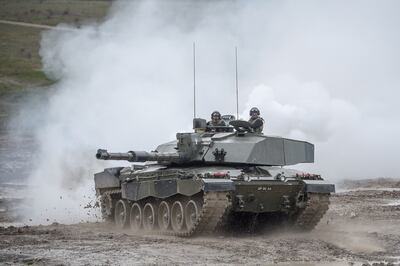Ukrainian troops are mostly surviving mine blasts and artillery strikes in their Nato-made equipment due to the “high survivability” of the armour, western officials have said.
It has also been disclosed that Ukraine has yet to commit the major part of its western tanks and infantry fighting vehicles, including British-supplied Challenger IIs.
The officials echoed what The National reported earlier this week, saying that Russian forces had “put up a good resistance”, falling back before counter-attacking in a well-co-ordinated fashion.
“This manoeuvre defence approach is proving challenging, hence the advance at the moment has been slow,” the source said. “The situation in the southern sectors remains highly confused.”
Images on social media have shown Ukrainian armour, including Leopard 2 tanks, lost to mines and artillery, but the crews have mostly survived.
“We've seen quite high survivability rates of personnel involved in vehicles,” the official said.
“If you contrast that with some of the Russian made equipment, which hit mines and completely ‘cooked-off’, you'll see that the Leopards hit remain largely intact and survived by most of the crews.”
In the briefing to media the officials also disclosed that they will demonstrate to President Vladimir Putin that “the West means it when it says that it'll be there for as long as it takes in support of Ukraine”.
“Over the coming weeks, you will start to see concrete actions which will back that up,” he added. “Vladimir Putin has to conclude that the longer he keeps fighting, the longer he will keep losing.”

Also, Mr Putin’s surprise admission that he had lost 54 Russian tanks in the last two weeks was “quite accurate” in a rare disclosure of battlefield casualties, he said.
The Ukrainians still have a number of their 12 combat brigades in reserve and will be committed to battle when they achieve a breakthrough.
The Russian air force, which has been markedly absent during the conflict, has “surged” over the southern area where the Ukrainians are sometimes advancing beyond the air defence bubble.

“This area has been more permissible for Russian aircraft than other parts of the country and is a short transit time from airbases in Crimea,” the official said.
But the high sortie rate would cause problems in the long term “as they'll be unable to maintain the surge due to serviceability and pilot fatigue.”
The Ukrainians are currently slogging through well-defended Russian lines but have yet to reach the main defensive belt that lies up to 20km inside occupied territory.
But it was unclear how many troops the Russians would have to man the defence lines once they are reached.
“The impact will be when they reach the main Russian line and what happens then and how many Russians are actually left,” the official said.
“But the idea that the Russians were going to melt away and the Ukrainians would just drive straight through their defensive lines was probably in people's wildest dreams … but the reality is that's not what we're going to see here.”
The Ukrainians were going to suffer casualties in a “hugely difficult” operation, he said, adding: “It's still too early to say as to whether it has been successful.”





